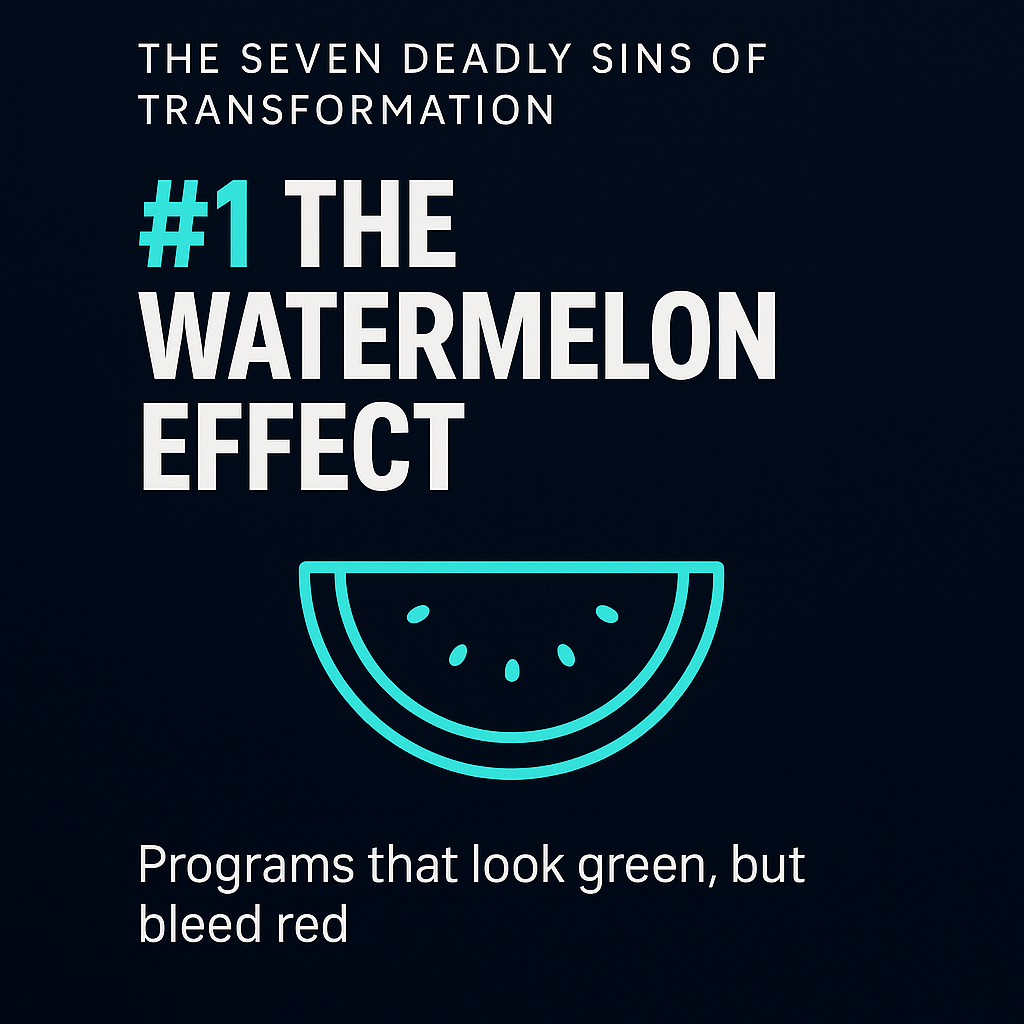
If you’ve ever cut open a watermelon, you’ll know the story: bright green on the outside, deep red at the core. Transformation programs can be the same — what looks “on track” often hides serious problems underneath. I call them watermelon programs.
In over 25 years leading major transformations globally, both at Deloitte and Accenture, and more recently at my own company Flux, I’ve seen this pattern repeatedly. Programs look green on dashboards, reports are polished, and confidence is high — but underneath, teams are spinning in circles, finger-pointing starts, and no one feels safe to tell the truth.
Watermelon programs seem to move fast, look successful, and yet fail spectacularly, costing hundreds of millions of dollars in wasted effort and shareholder or taxpayer money.
So, what causes this issue? And how can Boards and leaders address it? In my view the answer sits between culture and capability.
The Green Illusion
Most programs rely on RAG reporting — Red, Amber, Green.
Green = good. Amber = risk. Red = trouble.
Simple, right? Too simple. Transformation is complex. One colour cannot capture reality. Boards and executives must look below the surface to see the true status of streams, projects, and milestones.
Start with the mindset that green is the exception, not the rule.
The Green Cult
Behind every watermelon program sits a culture problem. There’s an unspoken cultural belief that “green is good.” Teams are rewarded for it. Vendors are paid for it. Executives are promoted for it.
So, people manage up, smooth the narrative, and report green — hoping to fix the real problems quietly later. But the longer the truth is hidden, the harder it becomes to recover. I’ve seen this pattern repeat across so many programs — the same story with different logos. People hide problems because green is rewarded – red is not.
The most effective leaders I’ve worked with create a culture of truth-telling. They ask, “What’s not working?” and “How can we help?”, and they reward transparency over compliance. Programs that surface amber or red early can drive decisions, build trust, and gain momentum.
Culture Shapes the Colour
Watermelon programs often spread beyond a single initiative, creating a company-wide culture that fears red. I’ve reviewed portfolios worth hundreds of millions of dollars where over 80% of programs reported green — sometimes by design, with enterprise wide KPIs explicitly targeting a green %.
Unsurprisingly, this drives perverse watermelon behaviour. Yet, when leaders set a tone of transparency, people stop hiding risk and turn reporting into problem-solving — and that’s when delivery gains real momentum.
The best CEOs make it safe to surface problems early. They ask, “What’s hard?” instead of just “What’s next?”, involve partners in solving issues, and reward critical thinking and problem-solving over a culture of “green is good.” Measure problems solved, not problems hidden.
Culture coupled with capability gaps cements the Watermelon Effect
Delivery and leadership teams that can’t plan effectively seriously compound the issue - quietly fuelling the Watermelon Effect. Plans are often built fast and shallow — detailed in the wrong places, missing the high-level sequence and logic that connects workstreams to strategy.
The advent of Agile has made this more complicated with teams using “we’re agile” as an excuse not to plan at all. Agile doesn’t replace planning — it just changes how you do it.
Confident reporting on a flawed plan masks the real problems. In watermelon programs no one wants to own up to a bad plan – so people convince themselves of various things to cover up – they redefine what a milestone meant, ignore critical dependencies or keep vendors silent amongst other masking tricks.
In my view the only way to know if your plans are robust is if you can confidently show the relationship between strategy, outcome, sequence and plan.
Planning and delivery capability means that the most dangerous of these misaligned programs are the ones that aren’t visibly off track — in fact they look like they’re on track.
How to spot a Watermelon
It not always easy, but a few leading signs I’ve learned to look for:
- You can’t see below the surface. If there’s only one status for the whole program, you’re not seeing the truth
- Decisions move too slowly. If major choices wait for a monthly steering committee, you’re managing history.
- No one’s asking for help. Silence usually means fear, not confidence.
- Red is taboo. If people think red means failure, you’ll never see it until it’s too late.
- The plan doesn’t hang together. If sequencing and dependencies are unclear, RED is already baked in.
How to avoid one…
- Ask for help early: Escalation isn’t failure — it’s maturity.
- Build decision flow: Governance is useless without speed and clarity of decisions – at all levels.
- Do top-down planning first: Know the execution strategy and sequence of activities to outcomes before the detail.
- Keep a Plan B ready: Flexibility is a strength, not a sign of weakness. Thinking is good.
- Drive transparency through culture: The tone from the top decides how deep the red goes before anyone sees it.
Final Thought
Every transformation hits moments of red. That’s normal — it’s where the real learning and problem-solving happens. The goal isn’t to stay green all the time; it’s to tell the truth early and often enough to stay in control. Encourage a culture of critical thinking and problem solving and you will find success is far more likely to be within reach.
